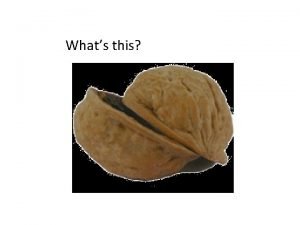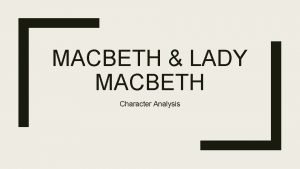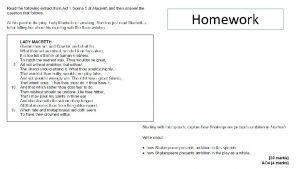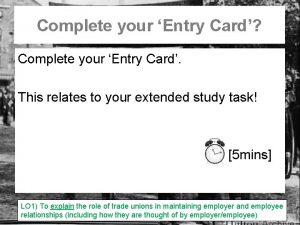Turn in Complete 1 Turn in your short










- Slides: 10

Turn in & Complete: 1. Turn in your short answer response from last Friday’s class (if you didn’t finish) 2. Turn in your Long Essay from Essential Question #3 3. Copy down your weekly calendar.

Unit 4 The Ante Bellum Period Part 8 • The New Two-Party System

• In the late 1700’s & early 1800’s politics were controlled by wealthy white men. In the North this meant merchants, bankers, & capitalists while in the South it meant large plantation owners. • While property owners were allowed to vote, nominations were controlled by the upper class. Since the Democratic Republicans enjoyed one-party rule, the nominee was virtually assured election. This system, known as King Caucus, was unpopular & seen as undemocratic.

• Voting restrictions based on property were challenged by the growing middle class, & by 1820 most states allowed voting for all white males. • Martin Van Buren helped create party government by building the first political machine. Party bosses selected candidates & used patronage (favors to political supporters) to stay in power.

• By the early 1820’s the Democratic Republican Party was split along regional lines. • In the 1824 presidential election all of the candidates were Democratic Republicans but each was a favorite son (supported by state & regional leaders). • Andrew Jackson & Henry Clay - West • William Crawford - South • John Quincy Adams – New England

• Although Andrew Jackson won the popular vote, no one had a majority in the electoral college. • The House of Representatives chose from the top 3 candidates. That eliminated Clay, who was Speaker of the House.

• Clay supported Adams even though Jackson had won the popular vote, & the House elected Adams president. Adams then made Clay his Secretary of State. Jackson supporters called this a “corrupt bargain”. • The election of 1824 split Democratic Republicans into distinct parties – the Democrats, led by Jackson, & the National Republicans, led by Adams.

• Adams supported Clay’s American System by asking Congress to fund internal improvements & raise tariffs. • The American System was unpopular in the South, especially the national bank & high tariffs which made goods more expensive.

• Adams was constantly attacked by Jackson’s supporters in Congress. • As a result, little meaningful legislation was passed, & what did pass was heavily criticized, such as the Tariff of 1828. • The Tariff of 1828 taxed imports of raw materials & iron goods, driving up prices. Southerners opposed the new tax & called it the Tariff of Abominations.

Age of Jackson video clip • As you watch, write down some things to fill in a tree map of Jackson’s presidency (successes and failures) – You’ll add to the map tomorrow as well, this is just your beginning impressions.
 Tall+short h
Tall+short h If your vehicle malfunctions turn on your hazard lights
If your vehicle malfunctions turn on your hazard lights Read the statement carefully in your notebook write agree
Read the statement carefully in your notebook write agree You can't turn right here. you turn left
You can't turn right here. you turn left Wash your hands put on your nightgown analysis
Wash your hands put on your nightgown analysis Answer. go straight turn left turn right
Answer. go straight turn left turn right Turn the arrow 1/4 turn clockwise
Turn the arrow 1/4 turn clockwise Lady macbeth character
Lady macbeth character Turn hell hound turn
Turn hell hound turn Turn left
Turn left Turn hell hound turn
Turn hell hound turn


















